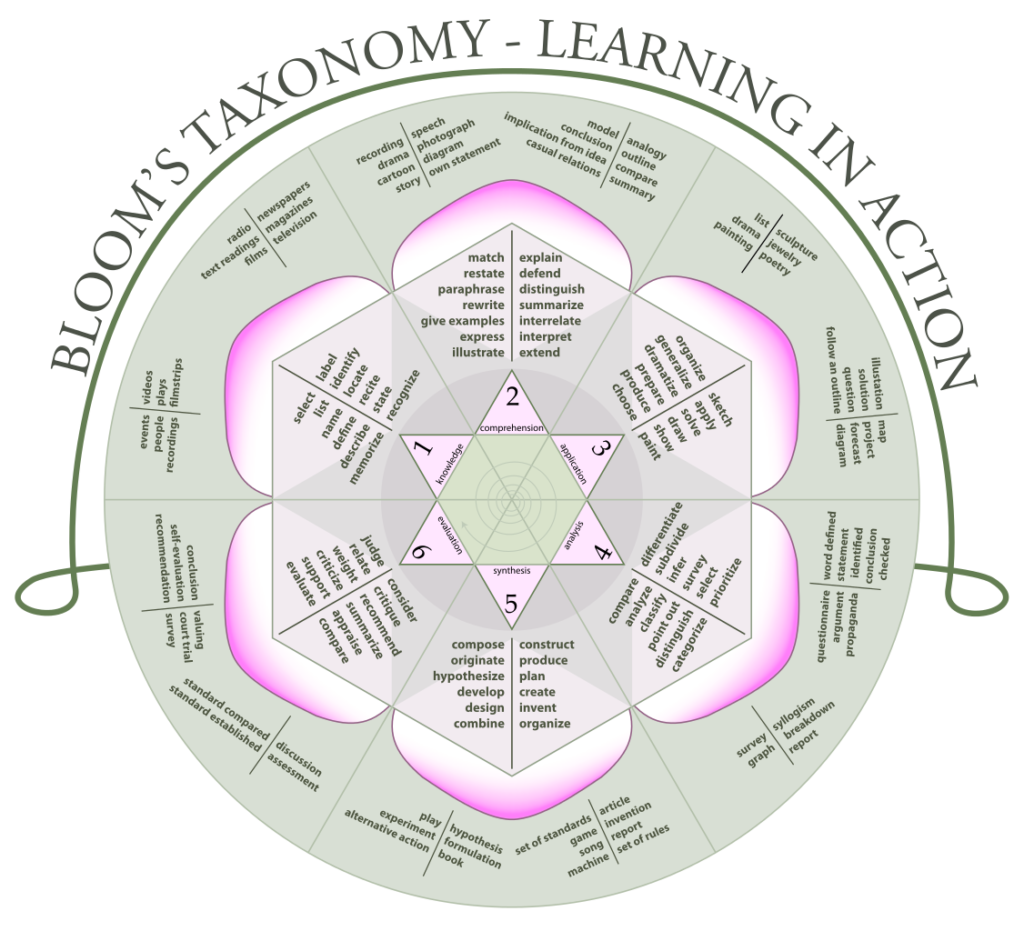A learning objective is a short statement of the goals and objectives that students should know or be able to put into practice after a lesson.
KEY POINTS
-
- Large-scale learning objectives will be articulated in a teacher’s curriculum guide, but it is up to each individual teacher to formulate learning objectives for individual lesson plans.
- In the middle of the twentieth century, a committee chaired by Benjamin Bloom created a well-known taxonomy of learning objectives.
- Benjamin Bloom’s learning objectives are built on the following template: VERB [which refers to a particular cognitive process] + OBJECT [which refers to the knowledge students are expected to acquire or construct].
TERM
- learning objective: Any fact, technique or other outcome that a student is expected to learn or achieve at the end of a specific course of instruction
FULL TEXT
A learning objective is a short statement of the goals and objectives that students should know or be able to put into practice after a lesson. Focusing on what students should know is frequently called the “cognitive” approach, focusing on what students should be able to do the “behavioral” approach. While most teachers are, by temperament, drawn to one of the two approaches, in practices most teachers often combine the two, perhaps without knowing it.
Large-scale learning objectives will be articulated in a teacher’s curriculum guide, but it is up to each individual teacher to formulate learning objectives for individual lesson plans. Teachers must find a way to disaggregate a large-scale learning objective (of the sort found in a curriculum guide) into a number of individual objectives.
In the middle of the twentieth century, a committee chaired by Benjamin Bloom created a well-known taxonomy of learning objectives. His learning objectives are built on the following template: VERB [which refers to a particular cognitive process] + OBJECT [which refers to the knowledge students are expected to acquire or construct]. The verbs themselves form a series which moves from relatively low-level cognitive processes like “remembering” toward high-level processes like “creating. ” A low-order learning objective, then, would be formed by joining a verb associated with “remembering” to the content to be acquired: “identify [VERB] the five major steps of photosynthesis [OBJECT]. ” A high-order learning objective, by contrast, would be formed by joining a verb associated with “creating” to the content to be acquired: “generate [VERB] a visual representation of photosynthesis within a plant cell [OBJECT]. ”
As is evident from the above example, Bloom’s taxonomy includes verbs associated with both the “cognitive” and “behavioral” approach. The committee Bloom chaired, in fact, created the taxonomy with the aim of designing a more holistic form of education.
Bloom’s Rose
Bloom’s wheel, according to the Bloom’s verbs and matching assessment types. The verbs are intended to be feasible and measurable.
Example Objectives
Knowledge (1):
The student will list the parts of a fish.
The student will recognize nouns in a sentence.
Comprehension (2):
The student will paraphrase the results of the survey.
The student will summarize types of governments.
Application (3):
The student will produce argumentative essays.
The student will sketch graphs using the data provided.
Analysis (4):
The student will categorize animals based on physical features.
The student will compare different ways of solving equations.
Synthesis (5):
The student will construct a program for addressing flood disaster relief.
The student will design stage props for a specific play.
Evaluation (6):
The student will criticize government policies on unemployment during the Great Depression.
The student will evaluate the use of U.S. propaganda during WWII.
Candela Citations
- Creating Learning Objectives. Authored by: Boundless. Located at: https://www.boundless.com/education/textbooks/boundless-education-textbook/curriculum-and-instructional-design-3/lesson-plans-and-learning-objectives-16/creating-learning-objectives-52-12982/. Project: Boundless Education. License: CC BY-SA: Attribution-ShareAlike
- Bloom's Rose. Authored by: K. Aainsqatsi. Provided by: Wikimedia. Located at: https://commons.wikimedia.org/wiki/File:Blooms_rose.svg. License: CC BY-SA: Attribution-ShareAlike
